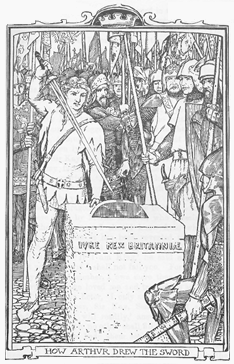The Structure and Style of Malory's Morte D'Arthur

John Spiers, 'Malory's "Morte D'Arthur"', in The New Pelican Guide to English Literature 1. Medieval Literature, 1997. John Spiers was Reader in English at Exeter University.
Malory's prose Morte D'Arthur (printed by Caxton 1485) is best approached after a reading of the English Arthurian verse romances which preceded it, rather than from the poetry of Tennyson and other poets who have since used it as a source. As Professor Vinaver has shown in his edition of the works of Malory, what is really a succession of separate prose romances has been given an appearance of unity, of being one 'book', by the way they were edited and printed by Caxton (under the misleading title of Morte D'Arthur). There could be no greater contrast than that between Malory's exceedingly 'literary' fifteenth-century prose romances and the English verse romantics or lays of the thirteenth and fourteenth centuries. Malory's prose, with all its seeming simplicity - it is a stylisation of earlier medieval prose - is in some respects the nearest thing in medieval English to the prose of Walter Pater. There is a tone of fin de siecle about Malory's book.
At the end of the Middle Ages and the end of a long efflorescence of medieval romance in many languages, Malory endeavoured to digest the Arthurian romances into English prose, using as his source chiefly an assortment of French Arthurian prose romances. But this traditional material has not been organised so as to convey any coherent significance either as a whole or, for the most part, even locally. Malory persistently misses the point of his wonderful material. (This may be partly because he had no access to the earlier and better sources - if we except the fourteenth-century English alliterative Morte Arthur- and was dependent, or chose to be dependent, on his French prose romances.) The comparison with Sir Gawain and the Green Knight is in this respect -as, indeed, in nearly all respects - fatally damaging to Mallory's Morte D'Arthur. . . What is it, then, that constitutes the charm of the book, that draws readers back to parts of it again? Partly, it is the 'magic' of its style - those lovely elegiac cadences of the prose, that diffused tone of wistful regret for a past age of chivalry, that vague sense of the vanity of earthly things. Yet the charm of the prose is a remote charm; the imagery is without immediacy; there is a lifelessness, listlessness, and fadedness about this prose for all its (in a limited sense) loveliness. There is also the fascination of the traditional Arthurian material itself, even though we feel it is not profoundly understood. The material fascinates the reader in spite of Malory's 'magical' style which seems to shadow and obscure rather than illuminate it. Malory's Grail books, for example, include some of the most fascinating of his original material. We find here once again the Waste Land, the Grail Castle, the Chaple Perilous, the Wounded King, and so on but reduced to little more than a succession of sensations and thrills. The recurrent appearance of the corpse or corpse-like figure on a barge and the weeping women - fragments of an ancient mythology though they are - become in Malory merely tedious after a number of repetitions, and the final effect is one of a somewhat morbid sensationalism.
Some qualifications of these structures should be made on behalf of the last four books of Caxton's Malory, which may be felt to have an impressive kind of unity of their own. The lawless loves of Lancelot and Guinevere, the break-up of the fellowship of the Round Table through treachery and disloyalty, the self destruction of Arthur's knights and kingdom in a great civil war, the last battle and death of Arthur, and the deaths of Lancelot and Guinevere have, as they are described, a gloomy power, and are all felt as in some degree related events. This set of events appears to have been deeply felt by Malory, partly as a reflection of the anarchy and confusion of the contemporary England of the War of the Roses.
(Source: Penguin Classic)
¡@
| Medieval Period | 16th Century | 17th Century | Restoration and 18th Century | English Department Homepage |